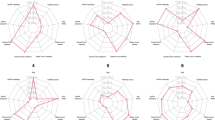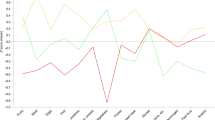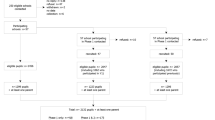Abstract
Background/objectives:
Research suggests obesity-related behaviours cluster together in children and adolescents, but how these cluster patterns differ by sociodemographic indicators remains unclear. Furthermore, few studies examining clustering of behaviours have included younger children or an objective measure of physical activity (PA) and sedentary behaviour. Therefore, the aim of this study was to examine clustering patterns of diet, PA and sedentary behaviour in 5- to 6- and 10- to 12-year-old children, and their cross-sectional associations with sociodemographic indicators.
Subjects/methods:
In this cross-sectional study, data from the baseline wave (2002/2003) of the Health Eating and Play study (HEAPS) were used. Questionnaires were completed by parents of Australian children aged 5–6 (n=362) and 10–12 years (n=610). Children wore accelerometers for up to 7 days. K-medians cluster analysis identified groups of children with similar diet, PA and sedentary behaviours. Chi-square tests assessed cluster differences by gender, maternal education and marital status.
Results:
For each age group, three reliable and meaningful clusters were identified and labelled ‘most healthy’, ‘energy-dense (ED) consumers who watch TV’ and ‘high sedentary behaviour/low moderate-to-vigorous PA (MVPA)’. Clusters varied by sociodemographic indicators. For example, a higher proportion of older girls comprised the ‘high sedentary behaviour/low MVPA’ cluster (χ2=22.4, P<0.001). Among both age groups, the ‘ED consumers who watch TV’ cluster comprised more children with lower educated mothers (younger children: χ2=34.9, P<0.001; older children: χ2=27.3, P<0.001).
Conclusions:
Identification of cluster patterns of obesity-related risk factors in children, and across sociodemographic groups may assist the targeting of public health initiatives, to those most in need.
This is a preview of subscription content, access via your institution
Access options
Subscribe to this journal
Receive 12 print issues and online access
$259.00 per year
only $21.58 per issue
Buy this article
- Purchase on Springer Link
- Instant access to full article PDF
Prices may be subject to local taxes which are calculated during checkout


Similar content being viewed by others

References
World Health Organization. Report of a joint WHO/FAO expert consultation. Diet, nutrition and the prevention of chronic diseases. WHO: Geneva, 2003, Report no.: TRS 916.
James WP . The epidemiology of obesity: the size of the problem. J Intern Med 2008; 263: 336–352.
Department of Health and Ageing, Department of Agriculture Fisheries and Forestry, Australian Food and Grocery Council. Australian National Children’s Nutrition and Physical Activity Survey: Main Findings. Commonwealth of Australia: Canberra, 2007.
Hardy LL, King L, Espinel P, Cosgrove C, Bauman A . NSW Schools Physical Activity and Nutrition Survey (SPANS) 2010: Short Report. NSW Ministry of Health: Sydney, 2011.
Telama R, Yang X, Viikari J, Valimaki I, Wanne O, Raitakari O . Physical activity from childhood to adulthood: a 21-year tracking study. Am J Prev Med 2005; 28: 267–273.
Lake AA, Mathers JC, Rugg-Gunn AJ, Adamson AJ . Longitudinal changes in food habits between adolescence (11-12 years) and adulthood (32-33 years): the ASH30 study. J Public Health 2006; 28: 10–16.
Biddle SJ, Pearson N, Ross GM, Braithwaite R . Tracking of sedentary behaviours of young people: a systematic review. Prev Med 2010; 51: 345–351.
Ford ES, Zhao G, Tsai J, Li C . Low-risk lifestyle behaviors and all-cause mortality: findings from the National Health and Nutrition Examination Survey III Mortality Study. Am J Public Health 2011; 101: 1922–1929.
Forsight. Government Office for Science. Tackling obesities: Future choices—Building the obesity system map. In: Department of Innovation Universities and Skills: UK, 2007.
Pronk NP, Anderson LH, Crain AL, Martinson BC, O'Connor PJ, Sherwood NE et al. Meeting recommendations for multiple healthy lifestyle factors. Prevalence, clustering, and predictors among adolescent, adult, and senior health plan members. Am J Prev Med 2004; 27: 25–33.
Ottevaere C, Huybrechts I, Benser J, De Bourdeaudhuij I, Cuenca-Garcia M, Dallongeville J et al. Clustering patterns of physical activity, sedentary and dietary behavior among European adolescents: the HELENA study. BMC Public Health 2011; 11: 328.
Cameron AJ, Crawford DA, Salmon J, Campbell K, McNaughton SA, Mishra GD et al. Clustering of obesity-related risk behaviors in children and their mothers. Ann Epidemiol 2011; 21: 95–102.
Boone-Heinonen J, Gordon-Larsen P, Adair LS . Obesogenic clusters: multidimensional adolescent obesity-related behaviors in the U.S. Ann Behav Med 2008; 36: 217–230.
Patnode CD, Lytle LA, Erickson DJ, Sirard JR, Barr-Anderson DJ, Story M . Physical activity and sedentary activity patterns among children and adolescents: a latent class analysis approach. J Phys Act Health 2011; 8: 457–467.
Pearson N, Atkin AJ, Biddle SJ, Gorely T, Edwardson C . Patterns of adolescent physical activity and dietary behaviors. Int J Beh Nutr Phys Act 2009; 6: 45.
Sanchez A, Norman GJ, Sallis JF, Calfas KJ, Cella J, Patrick K . Patterns and correlates of physical activity and nutrition behaviors in adolescents. Am J Prev Med 2007; 32: 124–130.
Landsberg B, Plachta-Danielzik S, Lange D, Johannsen M, Seiberl J, Müller MJ . Clustering of lifestyle factors and association with overweight in adolescents of the Kiel Obesity Prevention Study. Public Health Nutr 2010; 13: 1708–1715.
Seghers J, Rutten C . Clustering of multiple lifestyle behaviours and its relationship with weight status and cardiorespiratory fitness in a sample of Flemish 11- to 12-year-olds. Public Health Nutr 2010; 13: 1838–1846.
Turner K, Dwyer JJM, Edwards AM, Allison KR . Clustering of specific health-related behaviours among Toronto adolescents. Can J Diet Pract Res 2011; 72: e155–e160.
Huh J, Riggs NR, Spruijt-Metz D, Chou C-P, Huang Z, Pentz M . Identifying patterns of eating and physical activity in children: a latent class analysis of obesity risk. Obesity (Silver Spring, MD) 2011; 19: 652–658.
Liu J, Kim J, Colabianchi N, Ortaglia A, Pate RR . Co-varying patterns of physical activity and sedentary behaviors and their long-term maintenance among adolescents. J Phys Act Health 2010; 7: 465–474.
Gorely T, Marshall SJ, Biddle SJ, Cameron N . Patterns of sedentary behaviour and physical activity among adolescents in the United Kingdom: project STIL. J Behav Med 2007; 30: 521–531.
Marshall SJ, Biddle SJH, Sallis JF, McKenzie TL, Conway TL . Clustering of sedentary behaviors and physical activity among youth: a cross-national study. Pediatr Exerc Sci 2002; 14: 401–417.
Nelson MC, Gordon-Larsen P, Adair LS, Popkin BM . Adolescent physical activity and sedentary behavior: patterning and long-term maintenance. Am J Prev Med 2005; 28: 259–266.
Sabbe D, De Bourdeaudhuij I, Legiest E, Maes L . A cluster-analytical approach towards physical activity and eating habits among 10-year-old children. Health Educ Res 2008; 23: 753–762.
te Velde SJ, De Bourdeaudhuij I, Thorsdottir I, Rasmussen M, Hagstromer M, Klepp KI et al. Patterns in sedentary and exercise behaviors and associations with overweight in 9-14-year-old boys and girls—a cross-sectional study. BMC Public Health 2007; 7: 16.
Jago R, Fox KR, Page AS, Brockman R, Thompson JL . Physical activity and sedentary behavior typologies of 10-11 year olds. Int J Behav Nutr Phys Act 2010; 7: 59.
Salmon J, Campbell KJ, Crawford DA . Television viewing habits associated with obesity risk factors: a survey of Melbourne schoolchildren. Med J Aust 2006; 184: 64–67.
Australian Bureau of Statistics. Socio-Economic Indexes for Areas, 1996. ABS: Canberra, 1998, Report no.: Cat. No. 2033.0.30.001.
Australian Bureau of Statistics. Australian National Nutrition Survey (1995). ABS: Canberra, 1997, Report no.: Cat. No. 4801.0.
Willett W . Nutritional Epidemiology 2nd edn. Oxford University Press: New York, 1998.
de Vries SI, Bakker I, Hopman-Rock M, Hirasing RA, van Mechelen W . Clinimetric review of motion sensors in children and adolescents. J Clin Epidemiol 2006; 59: 670–680.
Rowlands AV . Accelerometer assessment of physical activity in children: an update. Pediatr Exerc Sci 2007; 19: 252–266.
Catellier DJ, Hannan PJ, Murray DM, Addy CL, Conway TL, Yang S et al. Imputation of missing data when measuring physical activity by accelerometry. Med Sci Sports Exerc 2005; 37: S555–S562.
Ward DS, Evenson KR, Vaughn A, Rodgers AB, Troiano RP . Accelerometer use in physical activity: best practices and research recommendations. Med Sci Sports Exerc 2005; 37: S582–S588.
Freedson P, Pober D, Janz KF . Calibration of accelerometer output for children. Med Sci Sports Exerc 2005; 37: S523–S530.
Trost SG, Loprinzi PD, Moore R, Pfeiffer KA . Comparison of accelerometer cut points for predicting activity intensity in youth. Med Sci Sports Exerc 2011; 43: 1360–1368.
Shrewsbury V, Wardle J . Socioeconomic status and adiposity in childhood: a systematic review of cross-sectional studies 1990-2005. Obesity (Silver Spring, MD) 2008; 16: 275–284.
Cole TJ, Bellizzi MC, Flegal KM, Dietz WH . Establishing a standard definition for child overweight and obesity worldwide: international survey. BMJ 2000; 320: 1240–1243.
Everitt BS, Landau S, Leese M, Stahl D . Cluster Analysis 5th edn. John Wiley & Sons, Ltd: West Sussex, 2011.
Lo Siou G, Yasui Y, Csizmadi I, McGregor SE, Robson PJ . Exploring statistical approaches to diminish subjectivity of cluster analysis to derive dietary patterns: the Tomorrow Project. Am J Epidemiol 2011; 173: 956–967.
Department of Health and Ageing. Australia’s Physical Activity Recommendations for 5-12 Year Olds. Department of Health and Ageing: Canberra, 2004.
National Health and Medical Research Council. Australian Dietary Guidelines. National Health and Medical Research Council: Canberra, 2013.
van der Sluis ME, Lien N, Twisk JWR, Steenhuis IHM, Bere E, Klepp K-I et al. Longitudinal associations of energy balance-related behaviours and cross-sectional associations of clusters and body mass index in Norwegian adolescents. Public Health Nutr 2010; 13: 1716–1721.
Pearson N, Biddle SJ . Sedentary behavior and dietary intake in children, adolescents, and adults. A systematic review. Am J Prev Med 2011; 41: 178–188.
Platat C, Perrin AE, Oujaa M, Wagner A, Haan MC, Schlienger JL et al. Diet and physical activity profiles in French preadolescents. Br J Nutr 2006; 96: 501–507.
Magarey A, Watson J, Golley RK, Burrows T, Sutherland R, McNaughton SA et al. Assessing dietary intake in children and adolescents: considerations and recommendations for obesity research. Int J Pediatr Obes 2011; 6: 2–11.
Bryant MJ, Lucove JC, Evenson KR, Marshall S . Measurement of television viewing in children and adolescents: a systematic review. Obes Rev 2007; 8: 197–209.
Sodergren M, Wang WC, Salmon J, Ball K, Crawford D, McNaughton SA . Predicting healthy lifestyle patterns among retirement age older adults in the WELL study: a latent class analysis of sex differences. Maturitas 2014; 77: 41–46.
Acknowledgements
The baseline wave of the Health Eating and Play study was funded by the Victorian Health Promotion Foundation. SA McNaughton is supported by an Australian Research Council (ARC) Future Fellowship (FT100100581). The funding bodies had no role in the analysis or preparation of the manuscript.
Author information
Authors and Affiliations
Corresponding author
Ethics declarations
Competing interests
The authors declare no conflict of interest.
Additional information
Supplementary Information accompanies this paper on European Journal of Clinical Nutrition website
Supplementary information
Rights and permissions
About this article
Cite this article
Leech, R., McNaughton, S. & Timperio, A. Clustering of children’s obesity-related behaviours: associations with sociodemographic indicators. Eur J Clin Nutr 68, 623–628 (2014). https://doi.org/10.1038/ejcn.2013.295
Received:
Revised:
Accepted:
Published:
Issue Date:
DOI: https://doi.org/10.1038/ejcn.2013.295
Keywords
This article is cited by
-
Clustering of diet, physical activity and sedentary behaviour and related physical and mental health outcomes: a systematic review
BMC Public Health (2023)
-
Examining adolescents’ obesogenic behaviors on structured days: a systematic review and meta-analysis
International Journal of Obesity (2022)
-
How physical activity, diet, and sedentary behavior cluster according to age in adolescents?
Sport Sciences for Health (2022)
-
Eating occasion situational factors and sugar-sweetened beverage consumption in young adults
International Journal of Behavioral Nutrition and Physical Activity (2020)
-
Clustering of diet, physical activity and sedentary behavior among Brazilian adolescents in the national school - based health survey (PeNSE 2015)
BMC Public Health (2018)


